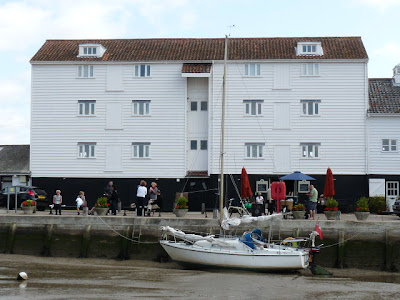Just after I arrived an officious man drove up and said I would need to move on at the next high tide. I thought he was joking at first, but he claimed to be the volunteer harbour master and as the tide mill was being renovated anybody being tied up there was a safety hazard. I spoke to him calmly and he ended up saying I could stay for the 3 days. I was totally confused.The ice cream seller said he was unaware of there being a harbour master and he was probably someone from the Town Council. Say no more I thought.
The cycle ride to Sutton Hoo is about 3 miles and takes you around the head of the creek. A woman told me it is up a steep hill, but this is Suffolk not Devon. They don't know what hills look like around here.
Despite the lack of any meaningful altitude, Hoo means high place and Deben means deep one. Woodbridge was thought to mean a place where there is a wooden bridge crossing the Deben and they looked for it for years. Its now thought to take its name from the Saxon god Woden.
The significance of Sutton Hoo became recognised in the late 30s when the owner of the land with all the mounds on ( Mrs. Pretty) asked a local archaeologist ( Basil Brown) to undertake a dig. Since her husband's death a couple of years before she had developed an interest in spiritualism and claimed to see people around the mounds.
Henry VIII required sites like this to be excavated so that any treasure could be used to fund the war with Spain. It's difficult to know what to think about such institutional plundering of our historic assets, but I guess it was a good cause at the time. If he hadn't done it there might not have been an England to name after these particular ancestors.
These tomb raiders used to go down through the centre of the mound and leave their calling card of a couple of broken beer mugs and the remains of a feast. However, as the end of one long mound had been removed as part of earlier farming works they missed the original middle of the one with the important ship burial. So when Brown did his careful opening up he discovered the original hoard. No body was found, and so claims that this was King Raedwald can not be proven. However, the acidic soil would have eaten away any organic matter so the lack of a body does not mean that there was no burial.
What Brown found initially were some metal rivets and the imprint of timber planking. When he located the artifacts the whole thing was hushed up. a police guard was mounted and responsibility for the dig was handed over to Charles Phillips of Cambridge University. The 2nd War then broke out and the military started using the site for tank training! Government care for our historic environment hadn't improved much since the middle ages, but again I guess there was a good cause.
A really good guide led a trip around the site. He said the boat was 90ft long and as we were with him we were allowed to stand on the mound. The bows were marked by posts and the boat had been aligned to point towards Denmark.He said being buried with all your wordly goods, would be the equivalent of being buried with your car, television and washing machine today!
He described the Deben as being the Dark Ages equivalent of Stanstead today. It was a busy place of arrival and departure. These mounds would have been visible from the river and would have been a statement of power and importance. Raedwald was so important because he was establishing an effective national monarchy here for the first time. He was also doing it on the cusp of a Pagan society and the arrival of Christianity. He sort of put his foot in both camps according to the exhibition. Politics has never changed !
The guide handed around a gold leaf replica of the buckle that was found in the boat. The exhibition showed a mixture of real finds, together with facsimiles.The workmanship is amazing. They may have had no need for the written word in such a barter economy, but they sure knew how to make things.
It was suggested that the helmet/facemask may have been believed to have Shamanic properties, so that when he put it on he probably believed he was Woden and so invincible.
Once again I found the maps with passage times on it fascinating.
Around the grounds various re-enactments were taking place of mock battles, and metal working. I always find it amusing to see these people sitting around eating and drinking. I think they should tuck themselves away somewhere to help maintain the illusion.
It was a good place to visit and was helped by the warm sunshine.Back on Hylje I started trying to decide which bits of the Thames Estuary to explore. I'm finding it pretty difficult. It seems to mean that you leave somewhere at high water and then fight the north going tide to inevitably arrive unhelpfully at low water if you are not going far.I'm sure I'll get the hang of it. I finished the afternoon off with a cycle along the riverside path to watch the boats enjoying the sunshine and the flooding tide.















No comments:
Post a Comment